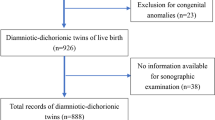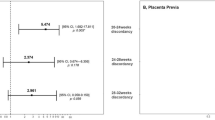Abstract
Objective:
We studied whether abnormal umbilical artery (UA) Doppler flow velocity waveforms occur with higher frequency in monochorionic diamniotic (MCDA) twin gestations with discordant fetal growth and whether this impacted neonatal outcome.
Study design:
We performed a retrospective study of MCDA twin pairs. We collected data from an electronic medical record. We classified pregnancies as discordant if there was at least 20% birth weight discordance. Abnormal UA Doppler velocity waveforms included absent or reversed end diastolic flow. We analyzed the data with chi square, Student’s t-test and analysis of variance as appropriate.
Result:
Seventy-three twin pairs met criteria for inclusion, including 16 with discordant growth. The discordant group was significantly more affected with twin-to-twin transfusion syndrome (TTTS) (P=0.02). The smaller fetuses in discordant pairs were more likely to display abnormal UA Doppler flow velocity waveforms (P<0.01). These neonates also had lower Apgar scores (P=0.03) and were more likely to require care in a neonatal intensive care unit. Our findings persisted after excluding pregnancies with TTTS.
Conclusion:
In MCDA twin gestations complicated by discordant growth, there is an increased frequency of abnormal UA Doppler flow velocity waveforms in small fetuses, and these neonates face clinical challenges after birth.
This is a preview of subscription content, access via your institution
Access options
Subscribe to this journal
Receive 12 print issues and online access
$259.00 per year
only $21.58 per issue
Buy this article
- Purchase on Springer Link
- Instant access to full article PDF
Prices may be subject to local taxes which are calculated during checkout
Similar content being viewed by others
References
Society for Maternal-Fetal Medicine Society for Maternal-Fetal Medicine, Simpson LL . Twin-twin transfusion syndrome. Am J Obstet Gynecol 2013; 208 (1): 3–18.
Quintero RA . Twin-twin transfusion syndrome. Clin Perinatol 2003; 30 (3): 591–600.
Demissie K, Ananth CV, Martin J, Hanley ML, MacDorman MF, Rhoads GG . Fetal and neonatal mortality among twin gestations in the United States: the role of intrapair birth weight discordance. Obstet Gynecol 2002; 100 (3): 474–480.
Lewi L, Gucciardo L, Huber A, Jani J, Van Mieghem T, Doné E et al. Clinical outcome and placental characteristics of monochorionic diamniotic twin pairs with early- and late-onset discordant growth. Am J Obstet Gynecol 2008; 199 (5): 511, e511–e517.
Acosta-Rojas R, Becker J, Munoz-Abellana B, Ruiz C, Carreras E, Gratacos E . Twin chorionicity and the risk of adverse perinatal outcome. Int J Gynaecol Obstet 2007; 96 (2): 98–102.
Adegbite AL, Castille S, Ward S, Bajoria R . Neuromorbidity in preterm twins in relation to chorionicity and discordant birth weight. Am J Obstet Gynecol 2004; 190 (1): 156–163.
Quintero RA, Morales WJ, Allen MH, Bornick PW, Johnson PK, Kruger M . Staging of twin-twin transfusion syndrome. J Perinatol 1999; 19 (8 Pt 1): 550–555.
Huber A, Hecher K . How can we diagnose and manage twin-twin transfusion syndrome? Best Pract Res Clin Obstet Gynaecol 2004; 18 (4): 543–556.
Hadlock F, Harrist R, Sharman R, Deter R, Park S . Estimation of fetal weight with the use of head, body, and femur measurements—a prospective study. Am J Obstet Gynecol 1985; 151 (3): 333–337.
Giles W, Bisits A, O'Callaghan S, Gill A . The Doppler assessment in multiple pregnancy randomised controlled trial of ultrasound biometry versus umbilical artery Doppler ultrasound and biometry in twin pregnancy. BJOG 2003; 110 (6): 593–597.
Zikulnig L, Hecher K, Bregenzer T, Baz E, Hackeloer BJ . Prognostic factors in severe twin-twin transfusion syndrome treated by endoscopic laser surgery. Ultrasound Obstet Gynecol 1999; 14 (6): 380–387.
Pan M, Chen M, Leung TY, Sahota DS, Ting YH, Lau TK . Outcome of monochorionic twin pregnancies with abnormal umbilical artery Doppler between 16 and 20 weeks of gestation. J Maternal Fetal Neonatal Med 2012; 25 (3): 277–280.
Author information
Authors and Affiliations
Corresponding author
Ethics declarations
Competing interests
The authors declare no conflict of interest.
Rights and permissions
About this article
Cite this article
Zuckerwise, L., Nayeri, U., Abdel-Razeq, S. et al. Doppler abnormalities in monochorionic diamniotic twin pregnancies with discordant growth. J Perinatol 35, 387–389 (2015). https://doi.org/10.1038/jp.2014.223
Received:
Revised:
Accepted:
Published:
Issue Date:
DOI: https://doi.org/10.1038/jp.2014.223



